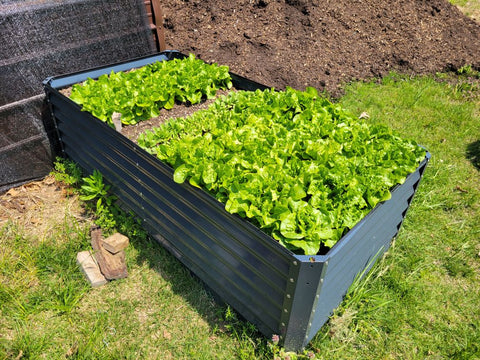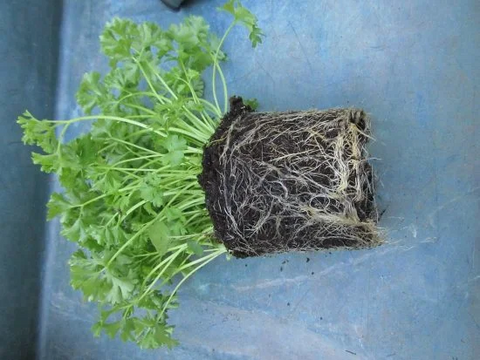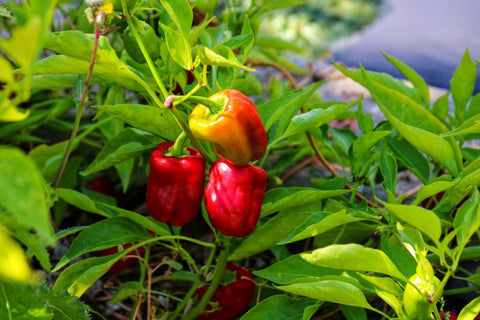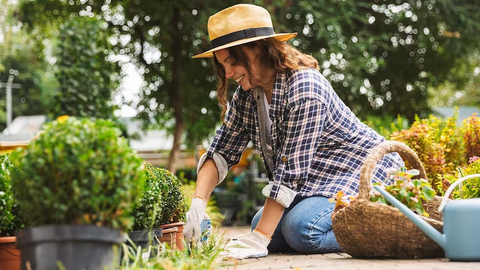As the new gardening season unfolds, it's the perfect time to set intentions and goals for your raised bed garden. Raised bed gardening offers a world of possibilities, from maximizing space to creating optimal growing conditions. In this blog, we'll explore a set of resolutions tailored for raised bed enthusiasts, helping you chart a course for a year filled with lush harvests, vibrant blooms, and a deeper connection to your green oasis.

Resolution 1: Optimize Soil Health
Healthy soil is the foundation of a flourishing garden. This year, resolve to prioritize and optimize the health of the soil in your raised beds. Consider the following steps:
- Invest in Quality Soil:
Begin the season by replenishing your raised beds with high-quality soil. Choose a well-balanced mix that provides essential nutrients for your plants. Consider adding organic matter, such as compost, to enhance soil fertility.
- Regularly Test Soil pH:
Monitor the pH levels of your soil throughout the year. Different plants thrive in specific pH ranges, so adjust the acidity or alkalinity as needed. Home soil testing kits or professional soil testing services can guide you in maintaining optimal conditions.
- Implement Cover Cropping:
Integrate cover crops during the off-season to prevent soil erosion and improve soil structure. Cover crops, such as clover or winter rye, also contribute organic matter, enriching the soil with nutrients.
- Rotate Crops Strategically:
Practice crop rotation to minimize nutrient depletion and prevent soil-borne diseases. Plan your planting layout to ensure that plants with similar nutrient needs are rotated through different areas of your raised beds each season.

Resolution 2: Maximize Vertical Space
One of the advantages of raised bed gardening is the potential to maximize vertical space. This resolution aims to make the most of every inch, offering more growing opportunities:
- Install Vertical Structures:
Incorporate trellises, cages, or stakes into your raised bed design to support climbing plants. Utilize vertical space for crops like tomatoes, cucumbers, peas, or beans. This not only optimizes space but also enhances air circulation, reducing the risk of certain diseases.
- Explore Vertical Gardening Techniques:
Embrace vertical gardening techniques, such as the use of hanging containers or wall-mounted planters. These methods allow you to grow herbs, flowers, or even compact vegetables vertically, turning empty walls or fences into productive growing areas.
- Experiment with Espalier:
Explore the art of espalier, a technique that involves training fruit trees or berry bushes to grow in a flat, two-dimensional form against a support structure. Espalier not only saves space but also adds an artistic element to your raised bed garden.
- Utilize Hanging Gardens:
Hang containers or baskets along the edges of your raised beds to cultivate trailing plants like strawberries or herbs. This not only enhances the aesthetic appeal of your garden but also utilizes previously unused space.
Resolution 3: Diversify Plant Selection
Diversifying your plant selection is an exciting way to introduce variety and balance into your raised bed garden. This year, make a resolution to expand your gardening horizons:
- Explore Heirloom Varieties:
Experiment with heirloom varieties of vegetables and flowers. These varieties often offer unique flavors, colors, and characteristics, adding a touch of heritage and diversity to your garden.
- Incorporate Companion Planting:
Embrace the principles of companion planting to enhance the health and productivity of your raised bed garden. Pairing plants that benefit each other can deter pests, improve pollination, and promote overall garden harmony.
- Introduce Pollinator-Friendly Plants:
Attract beneficial pollinators to your garden by incorporating flowers that appeal to bees, butterflies, and other pollinating insects. This not only supports biodiversity but also boosts the productivity of fruiting crops.
- Experiment with Ornamentals:
Don't limit your raised bed garden to edibles alone. Introduce ornamental plants for added visual interest. Mix flowers with vegetables, creating a beautiful and functional space that appeals to both the eye and the palate.

Resolution 4: Water-Wise Practices
Efficient water management is crucial in raised bed gardening, especially during warmer months. This resolution focuses on adopting water-wise practices to ensure a thriving garden while conserving this precious resource:
- Install Drip Irrigation:
Consider installing drip irrigation systems to deliver water directly to the base of plants, minimizing water wastage and keeping foliage dry. Drip systems are efficient, promote healthier root development, and reduce the risk of diseases caused by wet foliage.
- Mulch for Moisture Retention:
Apply a layer of organic mulch on the soil surface to conserve moisture, suppress weeds, and regulate soil temperature. Mulching helps retain water in the root zone of plants, reducing the frequency of watering.
- Water in the Morning:
Water your raised beds in the morning to allow plants to absorb moisture before the heat of the day. Morning watering reduces the risk of fungal diseases and ensures that plants are adequately hydrated.
- Collect Rainwater:
Set up rain barrels to collect and store rainwater for later use. This sustainable practice not only conserves water but also provides a natural and nutrient-rich source for your garden.
Resolution 5: Embrace Sustainable Practices
Elevate your raised bed gardening experience by adopting sustainable practices that contribute to a healthier environment. This resolution encompasses various eco-friendly approaches:
- Compost Kitchen Scraps:
Establish a composting system to turn kitchen scraps and garden waste into nutrient-rich compost. Incorporating compost into your raised beds enhances soil fertility and reduces the need for synthetic fertilizers.
- Integrate Beneficial Insects:
Encourage a healthy balance of insects in your garden by welcoming beneficial species that prey on pests. Ladybugs, predatory beetles, and parasitic wasps are examples of allies that can help control unwanted pests.
- Practice Integrated Pest Management (IPM):
Implement Integrated Pest Management strategies to address pest issues without resorting to chemical solutions. This may involve using natural predators, companion planting, or handpicking pests as needed.
- Save Seeds for Future Planting:
Save seeds from your favorite plants to grow in subsequent seasons. This sustainable practice not only preserves heirloom varieties but also reduces reliance on commercially produced seeds.
Resolution 6: Create a Garden Sanctuary
Transform your raised bed garden into a peaceful retreat by incorporating elements that promote relaxation and enjoyment. This resolution focuses on creating a garden sanctuary that nourishes the soul:
- Design Inviting Seating Areas:
Integrate comfortable seating areas within or adjacent to your raised beds. Whether it's a rustic bench, a cozy hammock, or a set of vibrant cushions, create spaces where you can unwind and appreciate the beauty of your garden.
- Add Decorative Elements:
Infuse your garden with decorative elements that reflect your personal style. Consider adding artistic sculptures, decorative plant markers, or handmade signage to enhance the visual appeal of your raised beds.
- Include Fragrant Plants:
Introduce fragrant herbs, flowers, or shrubs to stimulate your senses. Lavender, rosemary, or scented roses can add delightful aromas to your garden sanctuary, turning it into a sensory haven.
- Incorporate Ambient Lighting:
Extend the enjoyment of your garden into the evening by incorporating ambient lighting. String lights, solar lanterns, or strategically placed garden lights can create a magical atmosphere after sunset.

Resolution 7: Continuous Learning and Experimentation
Gardening is a journey of continuous learning and experimentation. This year, commit to expanding your knowledge and trying new techniques in your raised bed garden:
- Read and Research:
Invest time in reading gardening books, articles, and research relevant to raised bed gardening. Stay informed about new techniques, plant varieties, and sustainable practices to enhance your gardening skills.
- Attend Workshops and Classes:
Attend local gardening workshops or online classes to gain insights from experienced gardeners and horticulturists. Workshops provide practical knowledge and hands-on experience that can elevate your gardening proficiency.
- Keep a Garden Journal:
Maintain a garden journal to document your observations, successes, and challenges. A journal becomes a valuable resource for tracking planting schedules, experimenting with new varieties, and refining your gardening techniques.
- Connect with Fellow Gardeners:
Join gardening communities, either online or locally, to connect with fellow enthusiasts. Sharing experiences, exchanging tips, and seeking advice from others can enrich your gardening journey and provide a sense of community.
Conclusion
As you embark on a new gardening year, these raised bed gardening resolutions are designed to inspire and guide you toward a year filled with growth, abundance, and joy. Whether you're optimizing soil health, embracing sustainable practices, or creating a garden sanctuary, each resolution contributes to a more fulfilling and sustainable gardening experience. Remember, gardening is a dynamic and evolving process, and each raised bed is a canvas waiting for your creative touch. Here's to a year of elevated gardening and the bountiful rewards it brings. Happy gardening!









